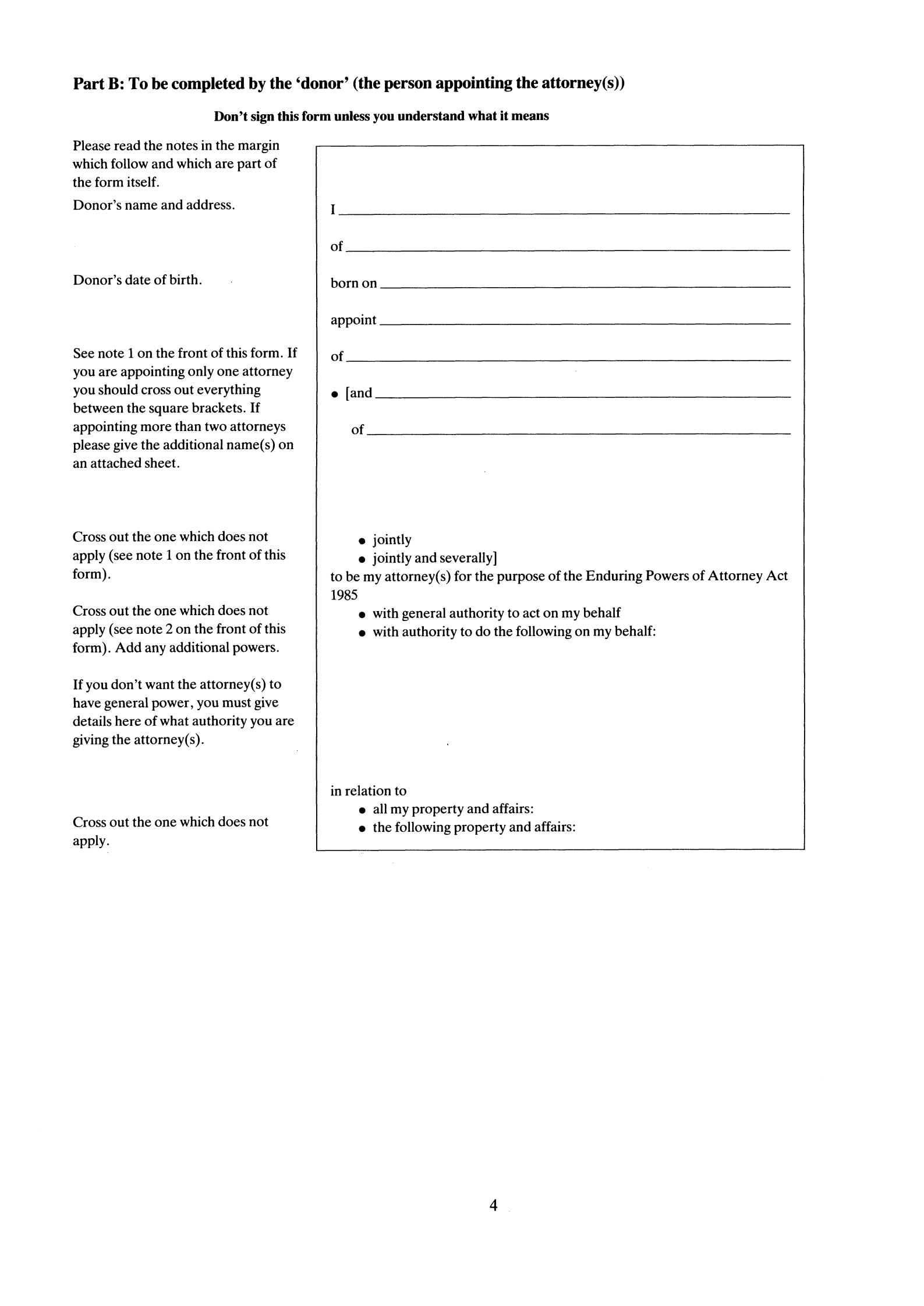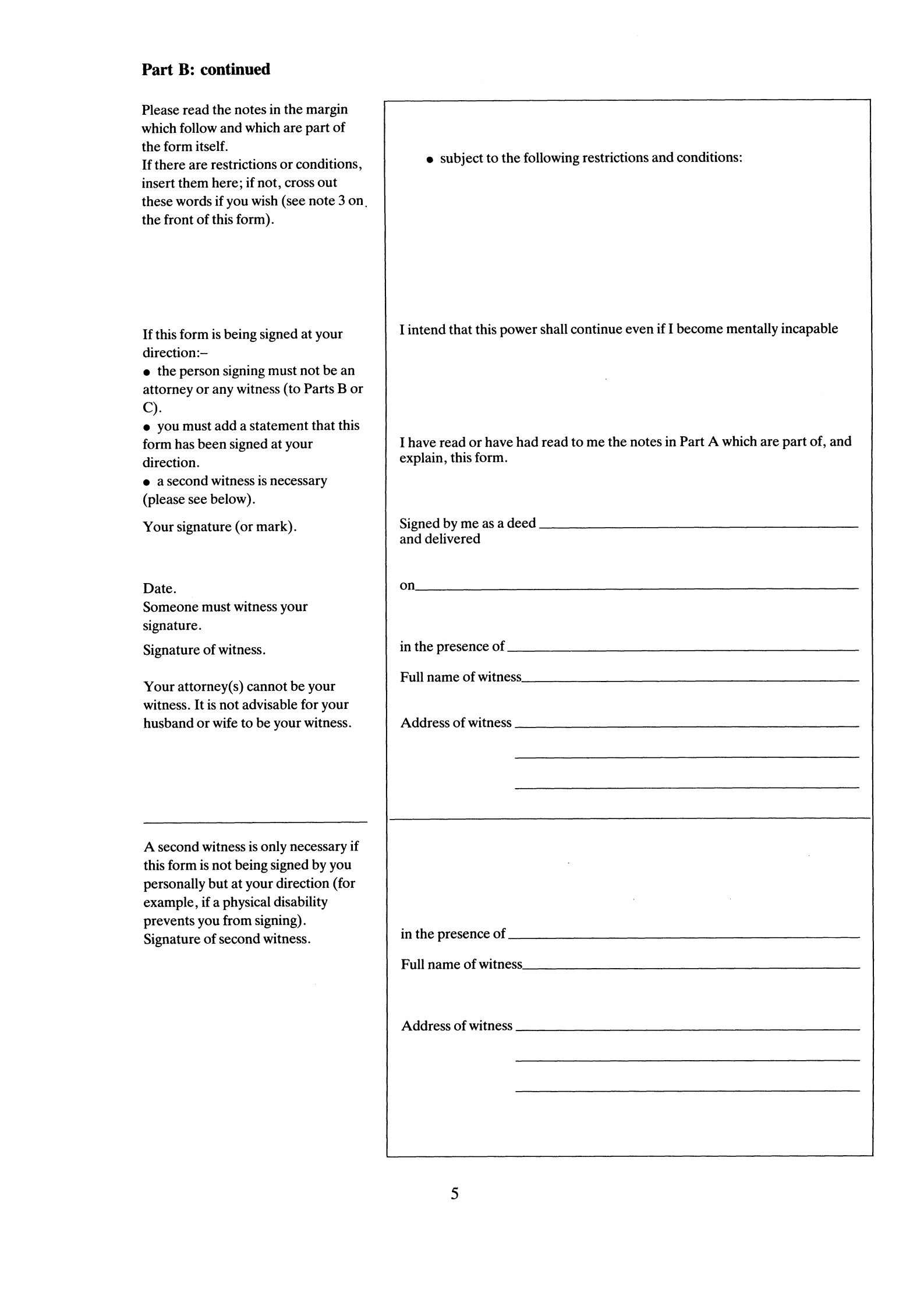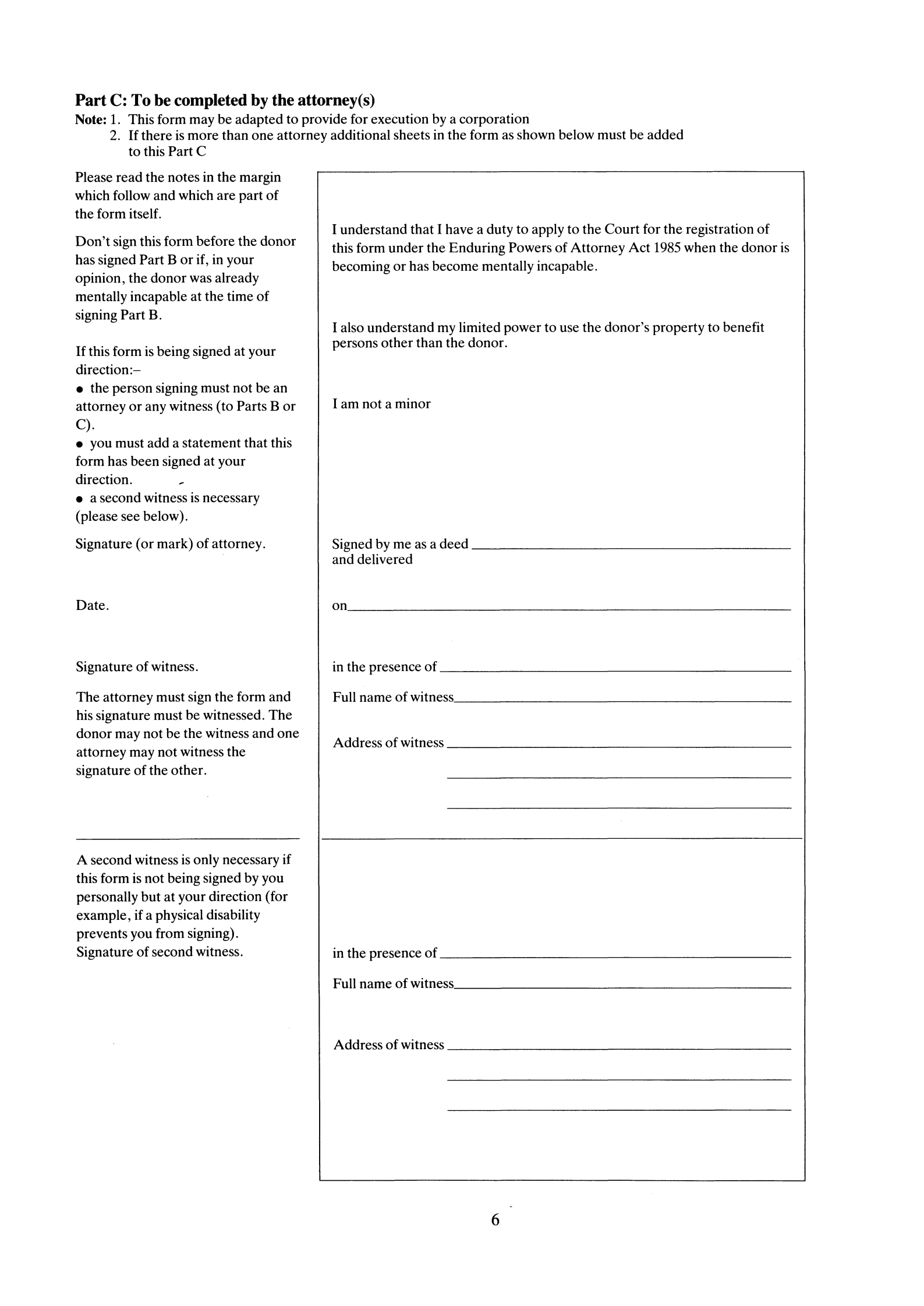- Latest available (Revised)
- Original (As made)
The Enduring Powers of Attorney (Prescribed Form) Regulations 1990
You are here:
- UK Statutory Instruments
- 1990 No. 1376
- Whole Instrument
- Previous
- Next
More Resources
Status:
This is the original version (as it was originally made). This item of legislation is currently only available in its original format.
Statutory Instruments
1990 No. 1376
POWERS OF ATTORNEY
The Enduring Powers of Attorney (Prescribed Form) Regulations 1990
Made
5th July 1990
Laid before Parliament
9th July 1990
Coming into force
31st July 1990
The Lord Chancellor, in exercise of the powers conferred on him by section 2(2) of the Enduring Powers of Attorney Act 1985(1), hereby makes the following Regulations:
Citation and commencement
1. These Regulations may be cited as the Enduring Powers of Attorney (Prescribed Form) Regulations 1990 and shall come into force on 31st July 1990.
Prescribed form
2.—(1) Subject to paragraphs (2) and (3) of this regulation and to regulation 4, an enduring power of attorney must be in the form set out in the Schedule to these Regulations and must include all the explanatory information headed “About using this form” in Part A of the Schedule and all the relevant marginal notes to Parts B and C. It may also include such additions (including paragraph numbers) or restrictions as the donor may decide.
(2) In completing the form of enduring power of attorney—
(a)there shall be excluded (either by omission or deletion)—
(i)where the donor appoints only one attorney, everything between the square brackets on the first page of Part B; and
(ii)one and only one of any pair of alternatives;
(b)there may also be so excluded—
(i)the words on the second page of Part B “subject to the following restrictions and conditions”, if those words do not apply;
(ii)the attestation details for a second witness in Parts B and C if a second witness is not required; and
(iii)any marginal notes which correspond with any words excluded under the provisions of this paragraph and the two notes numbered 1 and 2 which appear immediately under the heading to Part C.
(3) The form of execution by the donor or by an attorney may be adapted to provide—
(a)for a case where the donor or an attorney signs by means of a mark; and
(b)for the case (dealt with in regulation 3) where the enduring power of attorney is executed at the direction of the donor or of an attorney;
and the form of execution by an attorney may be adapted to provide for execution by a trust corporation.
(4) Subject to paragraphs (1), (2) and (3) of this regulation and to regulation 4, an enduring power of attorney which seeks to exclude any provision contained in these Regulations is not a valid enduring power of attorney.
Execution
3.—(1) An enduring power of attorney in the form set out in the Schedule to these Regulations shall be executed by both the donor and the attorney, although not necessarily at the same time, in the presence of a witness, but not necessarily the same witness, who shall sign the form and give his full name and address.
(2) The donor and an attorney shall not witness the signature of each other nor one attorney the signature of another.
(3) Where an enduring power of attorney is executed at the direction of the donor—
(a)it must be signed in the presence of two witnesses who shall each sign the form and give their full names and addresses; and
(b)a statement that the enduring power of attorney has been executed at the direction of the donor must be inserted in Part B;
(c)it must not be signed by either an attorney or any of the witnesses to the signature of either the donor or an attorney.
(4) Where an enduring power of attorney is executed at the direction of an attorney—
(a)paragraph (3)(a) above applies; and
(b)a statement that the enduring power of attorney has been executed at the direction of the attorney must be inserted in Part C;
(c)it must not be signed by either the donor, an attorney or any of the witnesses to the signature of either the donor or an attorney.
4. Where more than one attorney is appointed and they are to act jointly and severally, then at least one of the attorneys so appointed must execute the instrument for it to take effect as an enduring power of attorney, and only those attorneys who have executed the instrument shall have the functions of an attorney under an enduring power of attorney in the event of the donor’s mental incapacity or of the registration of the power, whichever first occurs.
Revocation
5. The Enduring Powers of Attorney (Prescribed Form) Regulations 1987(2) are hereby revoked, except that—
(a)a power executed in the form prescribed by those Regulations and executed by the donor before 31st July 1991 shall be capable (whether or not seals are affixed to it) of being a valid enduring power of attorney;
(b)regulation 3(3) shall apply to a power executed by the donor before 31st July 1991 under the provisions of those Regulations and the form of enduring power of attorney prescribed by those Regulations may be modified accordingly.
Mackay of Clashfern, C.
Dated 5th July 1990
Regulations 2 and 3
SCHEDULEENDURING POWER OF ATTORNEY
Part A: About using this form
1. You may choose one attorney or more than one. If you choose one attorney then you must delete everything between the square brackets on the first page of the form. If you chose more than one, you must decide whether they are able to act:
Jointly (that is, they must all act together and cannot act separately) or
Jointly and severally (that is, they can all act together but they can also act separately if they wish).
On the first page of the form, show what you have decided by crossing out one of the alternatives.
2. If you give your attorney(s) general power in relation to all your property and affairs, it means that they will be able to deal with your money or property and may be able to sell your house.
3. If you don't want your attorney(s) to have such wide powers, you can include any restrictions you like. For example, you can include a restriction that your attorney(s) must not act on your behalf until they have reason to believe that you are becoming mentally incapable; or a restriction as to what your attorney(s) may do. Any restrictions you choose must be written or typed where indicated on the second page of the form.
4. If you are a trustee (and please remember that co-ownership of a home involves trusteeship), you should seek legal advice if you want your attorney(s) to act as a trustee on your behalf.
5. Unless you put in a restriction preventing it you attorney(s) will be able to use any of your money or property to make any provision which you yourself might be expected to make for their own needs or the needs of other people. Your attorney(s) will also be able to use your money to make gifts, but only for reasonable amounts in relation to the value of your money and property.
6. Your attorney(s) can recover the out-of-pocket expenses of acting as your attorney(s). If you attorney(s) are professional people, for example solicitors or accountants, they may be able to charge for their professional services as well. You may wish to provide expressly for remuneration of your attorney(s) (although if they are trustees they may not be allowed to accept it).
7. If your attorney(s) have reason to believe that you have become or are becoming mentally incapable of managing your affairs, your attorney(s) will have to apply to the Court of Protection for registration of this power.
8. Before applying to the Court of Protection for registration of this power, your attorney(s) must give written notice that that is what they are going to do, to you and your nearest relatives as defined in the Enduring Powers of Attorney Act 1985. You or your relatives will be able to object if you or they disagree with registration.
9. This is a simplified explanation of what the Enduring Powers of Attorney Act 1985 and the Rules and Regulations say. If you need more guidance, you or your advisers will need to look at the Act itself and the Rules and Regulations. The Rules are the Court of Protection (Enduring Powers of Attorney) Rules 1986 (Statutory Instrument 1986 No. 127). The Regulations are the Enduring Powers of Attorney (Prescribed Form) Regulations 1990 (Statutory Instruments 1990 No. 1376).
Note to Attorney(s)
10. After the power has been registered you should notify the Court of Protection if the donor dies or recovers.
Note to Donor
11. Some of these explanatory notes may not apply to the form you are using if it has already been adapted to suit your particular requirements.
YOU CAN CANCEL THIS POWER AT ANY TIME BEFORE IT HAS TO BE REGISTERED
Part B: To be completed by the “donor” (the person appointing the attorney(s)
Part C: To be completed by the attorney(s)
Note:
1. This form may be adapted to provide for execution by a corporation
2. If there is more than one attorney additional sheets in the form as shown below must be added to this Part C
Explanatory Note
(This note is not part of the Regulations)
These Regulations prescribe a revised form of an enduring power of attorney, the explanatory information endorsed on it and the manner in which it is to be executed.
In particular these Regulations make amendments consequent upon the coming into force on 31st July 1990 of provisions in the Law of Property (Miscellaneous Provisions) Act 1989 (c. 34) which change the law relating to deeds and their execution.
S.I. 1987/1612.
Options/Help
Print Options
PrintThe Whole Instrument
Legislation is available in different versions:
Latest Available (revised):The latest available updated version of the legislation incorporating changes made by subsequent legislation and applied by our editorial team. Changes we have not yet applied to the text, can be found in the ‘Changes to Legislation’ area.
Original (As Enacted or Made): The original version of the legislation as it stood when it was enacted or made. No changes have been applied to the text.
More Resources
Access essential accompanying documents and information for this legislation item from this tab. Dependent on the legislation item being viewed this may include:
- the original print PDF of the as enacted version that was used for the print copy
- lists of changes made by and/or affecting this legislation item
- confers power and blanket amendment details
- all formats of all associated documents
- correction slips
- links to related legislation and further information resources
More Resources
Use this menu to access essential accompanying documents and information for this legislation item. Dependent on the legislation item being viewed this may include:
- the original print PDF of the as made version that was used for the print copy
- correction slips
Click 'View More' or select 'More Resources' tab for additional information including:
- lists of changes made by and/or affecting this legislation item
- confers power and blanket amendment details
- all formats of all associated documents
- links to related legislation and further information resources



